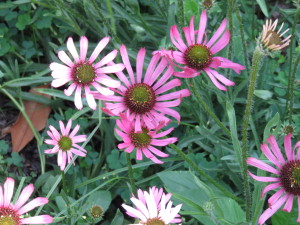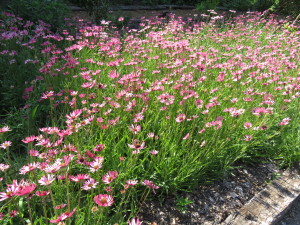Native to a two-county area of mid-Tennessee, Tennessee coneflower (Echinacea tennessiensis) is a popular favorite among gardeners across the U.S. because of its long blooming season. It has also spawned a few hybrid selections. The pale pink, flat-topped flowers with green and burgundy centers (cones) follow the tract of the sun across the sky.
From July thru September Tennessee coneflower has short, slightly upturned petals that are 2 to 3 inch across. Petals are not reflexed backwards as those of purple coneflower (E. purpureum).
Tennessee coneflower prefers moist well-drained soils until well-established. It is an ideal choice for hot sites and in rocky shallow soils. The species is best suited in full sun, but can cope with partial shade.
Tennessee coneflowers have no serious insect or disease problems. Japanese beetle, powdery mildew and leaf spot are occasional problems. They do not benefit from additional fertility which may actually weaken stems. Flowers attract many species of birds and butterflies. Deer do not normally feed on coneflowers.
Divide clumps when they become overcrowded every 4 to 5 years. Plants re-bloom without deadheading. Prompt removal of spent flowers improves general appearance. Group several plants together in a perennial border, meadow, or wildflower garden. Compact forms grow well in containers for a long bloom season.
Hybrid cultivars:
‘Rocky Top’ is a compost grower with pastel pink on 2 to 3 feet tall and 1 foot wide plants.
Pixie Meadowbrite™ is another compact form medium pink flowers. A true dwarf, each plant grows to 18 inches tall and 20 to 24 inches wide.
Once listed as endangered, Tennessee coneflower has now been de-listed and is easy to find in commerce.



 Posted in
Posted in 
